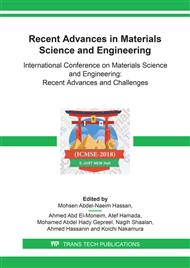[1]
H. Oliveira, P.L. Correia1, CrackIT– An Image Processing Toolbox for Crack Detection and Characterization, Instituto de Telecomunicações – Instituto Superior Técnico, 978-1-4799-5751-4/14, IEEE, (2014).
Google Scholar
[2]
S. Oka, S. Mochizuki, H. Togo and N. Kukutsu, A Neural Network Algorithm for Detecting Invisible Concrete Surface Cracks in Near-field Millimeter wave Images, IEEE International Conference on Systems, Man, and Cybernetics, San Antonio, TX, USA, (2009).
DOI: 10.1109/icsmc.2009.5346623
Google Scholar
[3]
R.G. Lins, S.N. Givigi, Automatic Crack Detection and Measurement Based on Image Analysis, IEEE TRANSACTIONS ON INSTRUMENTATION AND MEASUREMENT, VOL. 65, NO. 3, (2016).
DOI: 10.1109/tim.2015.2509278
Google Scholar
[4]
J. Valenca, D.D. Costa, E. julio, H. Araujo and H. Costa, Automatic crack monitoring using photogrammetry and image processing, Measurement 46, 433–441, Elsevier, (2013).
DOI: 10.1016/j.measurement.2012.07.019
Google Scholar
[5]
N.W. Pech-May, A. Oleaga, A. Mendioroz and A. Salazar, Fast Characterization of the Width of Vertical Cracks Using Pulsed Laser Spot Infrared Thermography, J Nondestruct Eval, (2016).
DOI: 10.1007/s10921-016-0344-x
Google Scholar
[6]
S.Y. Alam, T. Lenormand, A. Loukili and J.P. Regoin, Measuring crack width and spacing in reinforced concrete members, FraMCoS-7, Korea, (2010).
Google Scholar
[7]
B. Ge, Q. Luo, B. Ma, Y. Wei, B. Chen and S. Jiang, The Algorithm to Measure Crack Width with Incircle, Advanced Materials Research Vol. 684, pp.481-485, (2013).
DOI: 10.4028/www.scientific.net/amr.684.481
Google Scholar
[8]
L. Meng, W. Zhong-yu and S. Mei, Width Measurement of Metal Surface Cracks Based on Image Analysis Technique, Beihang University, Beijing, China, 100083, 86-10-82339303.
DOI: 10.1007/978-1-84628-988-0_58
Google Scholar
[9]
Y. Lu, L. Ye, Z. Su, L. Zhou and L. Cheng, Artificial Neural Network (ANN) based Crack Identification in Aluminum Plates with Lamb Wave Signals, Journal of Intelligent Material Systems and Structures, Vol. 20, (2009).
DOI: 10.1177/1045389x08088782
Google Scholar
[10]
A.A. Elshafey, N. Dawood, H. Marzouk and M. Haddara, Crack width in concrete using artificial neural networks, Engineering Structures, Elsevier, 52, 676–686, (2013).
DOI: 10.1016/j.engstruct.2013.03.020
Google Scholar
[11]
C. Avila, Y. Shiraishi and Y. Tsuji, Crack Width Prediction of Reinforced Concrete Structures by Artificial Neural Networks, 7th Seminar on Neural Network Applications in Electrical Engineering, NEURAL-2004, IEEE, (2004).
DOI: 10.1109/neurel.2004.1416529
Google Scholar
[12]
J. Yao, L. Cao and J. Huang, Prediction of Diagonal Crack Widths of High-Strength Reinforced Concrete Beam by Artificial Neural Network, Advanced Materials Research, Vol. 163-167, (2011).
DOI: 10.4028/www.scientific.net/amr.163-167.992
Google Scholar
[13]
H.M. Shehata, Y.S. Mohamed, M. Abdellatif and T.H. Awad, Depth Estimation of Steel Cracks Using Laser and Image Processing Techniques, Egypt-Japan University of Science and Technology, E-JUST, New Borg El-Arab City, Alexandria, Egypt, AEJ, 2017 [Accepted].
DOI: 10.1016/j.aej.2017.10.006
Google Scholar


